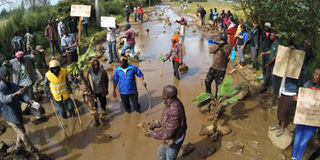Residents grapple with diseases in dusty Katani

Residents of Katani demonstrate over the poor state of Katani road in January. The state of the road has become a health concern. JEFF ANGOTE | NATION
The ground is always shaking, the air dusty and noise has become the norm in Katani, Machakos County, putting the health of residents at risk.
Daily, trucks transport murram from more than 40 quarries that supply building materials to Nairobi. The piles of murram at the quarry entrances is the first stage of a much bigger rock blasting project, making noise pollution a constant.
A policy brief report on Athi River town of Machakos said high exposure to inhalable dust had increased respiratory health problems among residents.
The research, carried out in October 2019 by Faridah Were and University of Nairobi said the industrial activities within the area were the major sources of inhalable dust.
Other contributors were unpaved road traffic emission and socio-economic activities.
The dust persists in the breathing zone and penetrates deeper into the respiratory systems of those in the vicinity, creating a risk of occurrence of respiratory diseases. The report added that high prevalence of respiratory diseases was heightened by the semi-arid conditions of the sub-county that limited natural regeneration of degraded vegetation cover, thereby increasing the vulnerability of the communities.
RESPIRATORY DISEASES
Hospital visits due to respiratory health complications, said the report, were observed to be on the rise in sub-counties of Machakos.
The average concentrations of inhalable dust in classrooms within Athi River exceeded the recommended WHO Air Indoor Quality Limit.
Athi River schoolchildren had significantly higher prevalence of respiratory diseases than a control group studied.
They had various types of pulmonary impairments such as obstruction of large and small airways. “Despite the gross limitation of health data on cardiovascular diseases from several, but ill equipped private health facilities in Athi River, it was evident that the hospital visits by the community increased with increasing levels of inhalable dust during the study period. The majority of complaints were respiratory related ailments,” said Were.
Isaiah Khaemba, zone leader Waumini estate, said: “There is so much dust and no one has taken responsibility to control the air pollution.”
Administrator Katani Hospital Protas Makani said the community living near the quarries mainly visited the facility with complications such as bronchitis, allergies and eye problems. The dust destroys the alveoli.
"If the trend continues, the people will face far-reaching consequences caused by the dust," he said.
NEMA RESPONSE
Makani said the particles inhaled could also get into the blood stream, enter the gallbladder, resulting in an operation in case they enter the appendix.
The hospital opened its door two years ago and the noise has been a bother to patients.
He said children and the elderly were the most affected.
In a week, they get about eight patients that are suffering from dust-related complications.
The trucks have also destroyed the roads there. "I have to take a patient to Syokimau since the ambulance cannot use the bad road," he said. "I once had a patient that had a fractured leg, but the ambulance took one hour to transport him from this place to the hospital."
Despite sending several letters to National Environment Management Authority, the agency has only responded once since 2018. A response by the agency, dated January 1, 2018, by Machakos director of environment said dust on the roads should be handled by the county. The director added that such a directive was impossible to enforce.



